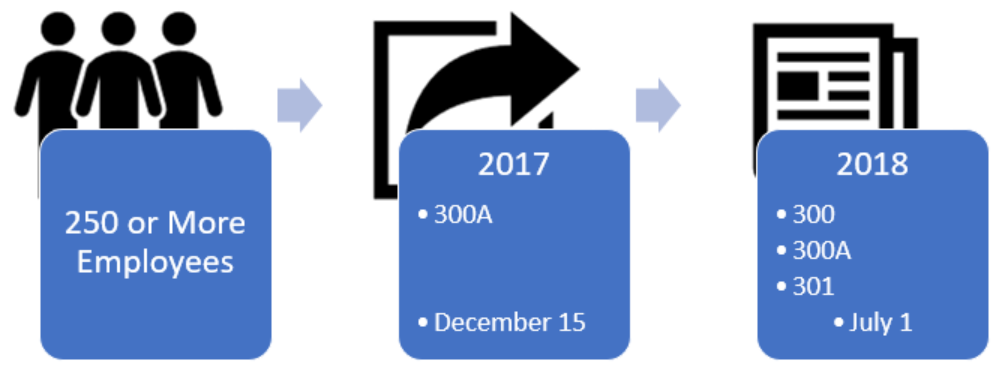|
The new effective date for electronic submission has been extended to December 15, 2017. WHO: This applies to establishments with 250 or more employees and establishments with 20-249 employees that are classified in certain industries that have high rates of occupational injuries and illnesses. State Exceptions: California, Illinois, Maine, Maryland, New Jersey, New York, South Carolina, Utah, Washington, and West Virginia – have not adopted the requirement to submit injury and illness reports electronically. WHEN 20-249 Employees: WHEN 250+ Employees: HOW:
There are three methods for data submission:
If this is something that you would be interesting in discussing let me know! Stay posted for me details. Craig Bengel [email protected]
0 Comments
Interesting Finds:
Good News: The good news is overall the number of citations written is down for the top 10 list besides Fall Protection training. But, with several months of data to go, there is still time left in the year and it will be interesting to see what the final citations numbers will be. Another positive from this list is that all citations can be avoided through proper training and ensuring employees are complying with the training. Another key aspect of training, is to ensure you have the proper documentations for the training. A record management system, like STAC, is a great resource that can be used to maintain all your employee training records. Thoughts: Is there anything that surprised you about the new Top 10 List? What areas in the Top 10 do you typically deal with, and what training do you provide in those areas? Is there something that you do not currently train on that you might need assistance? Craig Bengel 513-582-3888 [email protected] Lessons Learned from a Drill Sergeant And how They can be Applied to Safety in the Workplace
While Veteran’s day has come and passed last weekend, I had time to reflect on what I had learned while I attended basic training at Fort Jackson, South Carolina. From that reflection I remember three important things echoed from my Infantry Drill Sergeant that hold true in Safety. These lessons are common across the Army, but not as common in the civilian world, so I figured I’d share these wisdoms. Lesson 1 “Slow is Smooth, Smooth is Fast” Those words were echoed by my Drill Sergeant while I was attempting to qualify with my assigned M16. When first heard, the expression sounds counterintuitive, how could going slow actually make me faster? Well for starters multiple factors come into play when firing a weapon, breathing, trigger squeeze, and site picture to name a few. But, the slower and smoother that you can handle these factors, better results will occur with increased effective and accurate fire toward the target. This same principle can be applied to safety in the workplace. All too often we hear the term “hurry up, but be safe.” The implication from these terms is get the job as quick as possible with whatever tools necessary. However, many accidents and injuries can be prevented if the worker uses a slower, but smoother pace of work and constantly thinking and pre-planning for the next step and potential hazard. Lesson 2 “Stay in Your Lane” Not to get too bogged down in Military tactics, but essential while assaulting a position, the group assaults forward walking in your assigned “lane.” This lane is a straight line that you walk in, you do not deviate left of right as you might walk into the firing lane of your battle buddy. The good thing about staying in your lane is that you know exactly what sector of fire is your responsibility. It sounds easy enough, but walking in a straight line with obstacles, like thorns and bushes, creates hazards. Therefore, effective training is needed to ensure this concept is maintained. This same concept can be applied to new workers trying to learn to stay in their lane. However, obstacles and hazards always present themselves. Studies have found that new employees are SIX Times more likely to be injured in the first month, than workers with more than one-year experience. So, effective safety and task training is essential to ensure they know their roles and responsibilities. An effective way to do that is through new hire employee orientation and using a mentor system. Lesson 3 “Get Smart or Get Strong” This concept seems simple, learn from your mistakes and the less time you will be in the front-leaning rest position (the push-up). Unfortunately, with thrown into a random group of people, sometimes people learn at different paces. And for my basic training platoon we got stronger than smarter. In the workplace having smarter workers is far superior to “stronger” workers. A worker that relies on strength alone will eventually overexert himself/herself. For injuries that lasted over 6 days, overexertion (lifting, pushing, pulling, holding, carrying or throwing) was discovered to be the reason for 25.3% of the injuries. The direct cost alone of these injuries was $15.1 billion! A simple way to avoid these injuries is to be smarter; use proper lifting techniques, ask for help when lifting, and use mechanical equipment to aid in lifting that requires little to know exertion. So, don’t just rely on getting stronger, focus on getting smarter. Although simple, remembering these three basic principles can be applied to the culture of your safety program and hopefully press the mindset to stay safe and remember the lessons of those before you. Listen to part of the STAC story with our founder's interview on American Dreamers:
http://www.americandreamers.biz/brent-sexton-w-stac/ |
AuthorSTAC Admin Categories
All
Archives
July 2024
|






 RSS Feed
RSS Feed